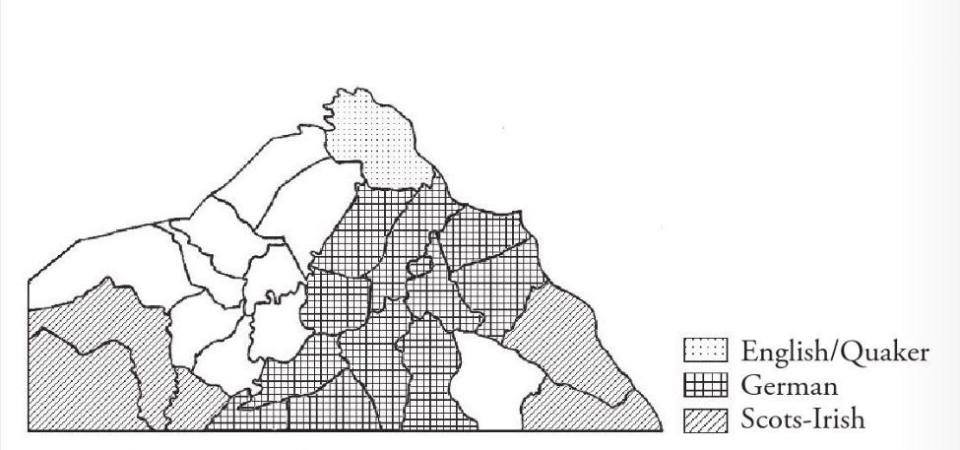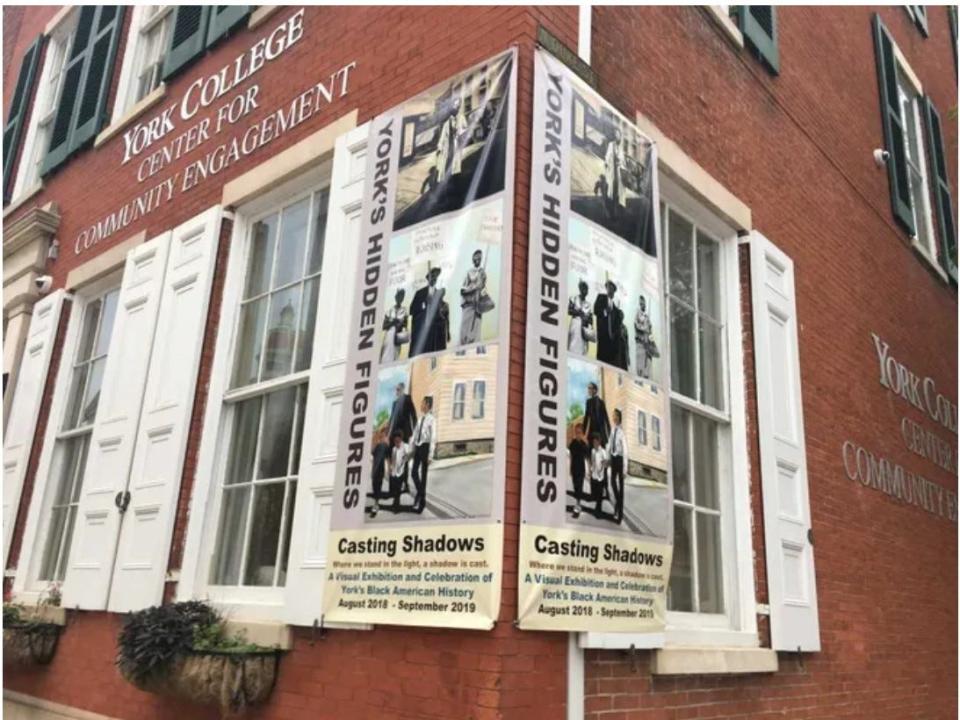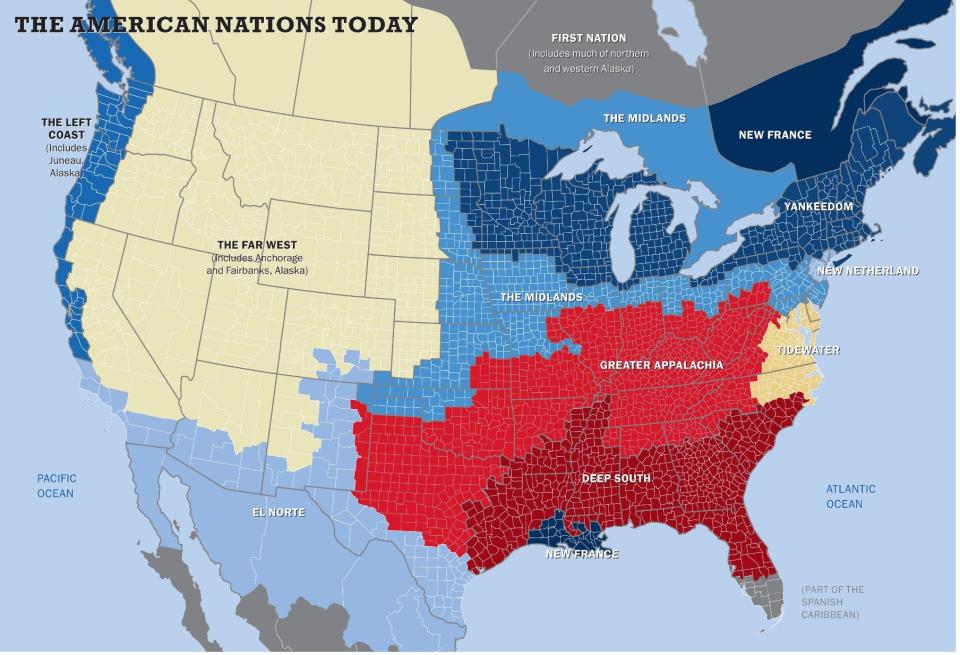York County stands in the ‘Midlands,’ with exposure to three other ‘nations’
- Oops!Something went wrong.Please try again later.
(This is another in a series of occasional columns about York County borders and how they helped make York County, York County).
Some decades ago, one of my graduate school professors discouraged use of the word “just” in class.
Nothing is just this or just that, he said. His point is that people, places and things bear more complexity than they seem at first look — or even second glance.
That notion is spot on when applied to York County: 910 square miles of rolling hills that some for decades have caricatured as just an isolated, rock-ribbed, far-right enclave whose residents would feel at home in a remote region of Alabama. Some would say we’re “just” the first capital of “Pennsyltucky.”
Those who hold this flawed view of the county and its residents should ponder “a while” about things that belie a complex place filled with ironies and paradoxes.

York County, the hub
In the 1700s, this land west of the Susquehanna River was on a major north/south travel route for immigrants from Europe. Roads sprawled in all directions because, as today, York County was an early American hub. We’re in the middle of everything — except today’s two-hour drive was originally a two-to-four-day ride via horseback or wagon.
Travelers came and went from this border county, some settled and then moved on and others stayed. Visitors and local residents exchanged information, swapping news and equipping each other for the rigors of frontier life.
York, the first Pennsylvania county west of the Susquehanna, developed its own personality, maybe taking on the grittiness of nearby Baltimore and elsewhere south of the Mason-Dixon Line rather than the urbanity of Philadelphia, America’s largest city.
The county’s hub status came from its position where North met South and a 65-mile border carved by the Mason-Dixon Line with Maryland. The county was the first stop for travelers from the South in a state tagged as the Keystone between the northeast and southeast and in a region called the Mid-Atlantic.
Further, York County is a geographically large county that grew from four very different regions or hearths:
The Hanover/Adams area with its English Catholics and Scots-Irish Presbyterians.
The Presbyterian Delta-Stewartstown area with Scots-Irish settlers.
The great Pennsylvania Dutch central valley carved by the Codorus Creek with its strong German Protestant denominations.
The land north of the Conewago Creek with its English Quakers.
Differences among regions in where people shop and work and even the sports teams they root for persist today.
There’s nothing just simple about York County, then or now.

County in the Midlands
Now comes another layer to pile on.
Award-winning historian/journalist Colin Woodard enters the mix with his 2011 book, “American Nations: A History of the Eleven Rival Regional Cultures of North America.” The book intentionally divides the country into nations or regions and shows how these fractures have played out in history.
When I first saw the book several years ago, I immediately went to its cover map to locate which nation claimed York County.
There we were in the “Midlands,” in a group of counties and states that extended as far west as New Mexico. The Midlands is filled with swing states because of the nature of its people and their historic voting patterns.
Woodard introduced the Midlands this way: “Pluralistic and organized around the middle class, the Midlands spawned the culture of Middle America and the Heartland, where ethnic and ideological purity have never been a priority, government has been seen as an unwelcome intrusion and political opinion has been moderate, even apathetic.”
I’m thinking you can see pieces of York County in this description?
Proximity to three nations
When you stare at Woodard’s map, you see something else that suggests complexity.
While the Midlands claims the county, three other “nations” are near enough to potentially exert influence: Yankeedom, Tidewater and Greater Appalachia.
Yankeedom runs across the northern tier of Pennsylvania. When you travel to Luzerne County and Wilkes-Barre, you cross the border to a nation that includes New England.
Woodard writes that Yankeedom’s residents, middle class in character, believe in the greater good of a community and the potential of government to improve lives.
My view is that you might gain a glimpse of York County people north of the Conewago Creek in this description, a region in which more than half of its residents commute to the Harrisburg area and many presumably work for a state government designed to improve lives.
Tidewater is a second nearby region in Woodard’s map that includes Delaware, Maryland’s Eastern Shore and southern Maryland, northern Virginia and Washington, D.C. People in this region are characterized by a high respect for authority and place little value on equality and public participation in politics.
In my view, it’s important that the southeastern part of York County is less than 25 miles from Delaware in air miles. And an immigration route for Scots-Irish and other settlers ran from the port of New Castle in Delaware to the Susquehanna, where settlers ferried across the Lower Susquehanna to York County.
It’s a sad fact of county history that southeastern York County and western lands now part of Adams County — both Scots-Irish strongholds — held the highest number of enslaved people in the county before 1800. The southeastern corner of York County thus joined neighbors Lancaster and northern Maryland and Tidewater’s Delaware for a continuous region of enslaved people.
To be sure, some of Yankeedom’s and Tidewater’s traits don’t play well in York County. After all, they’re rival nations.
Yankeedom’s reliance on government didn’t reach York County south of the Conewago with its many local government units diluting centralized power.
And York County’s view that the best government is one that governs least translates to a low respect for authority, contra to the Tidewater position. An example of this view is county residents’ strong opposition to the nationally imposed Whiskey Tax in the 1790s.
And this low view of authority coupled with disregard for intrusive government could explain why York County has produced only two governors and little other prominence on the state or national political level until the 2010s.

Greater Appalachia influential
A third nation, Greater Appalachia, might have exerted the most influence on York County because this nation is large, nearby and in line with York County’s historic southward tilt.
Woodard’s map places its Pennsylvania border at the western edge of Franklin County. Until 1800, York County’s western border touched Franklin County’s eastern boundary. Greater Appalachia borders the Deep South and sprawls as far west as New Mexico. Folks of this largely rural, often mountainous nation help prompt the derisive terms “hillbilly” and “redneck.”
Woodard notes that folks in this region come from Northern Ireland, Northern England and the Scottish Lowlands, borderland places accustomed to war and other conflicts. This background, common with Presbyterians, fostered a warriorlike ethic and deep commitment to personal sovereignty in America.
I think parts of York County’s character can be seen from ideas crossing nation Appalachia to Midlands boundaries. For example, it’s interesting that spirited proponents of a movement to carve a separate county from the Hanover region in 1837 would have called their new domain Jackson County, after the first president from Greater Appalachia, Andrew Jackson.
And as we’ve seen, York County in the “Midlands” hosted Scots-Irish enclaves of its own — in its southeastern and southwestern regions. Also, Presbyterians founded Dillsburg area, and many lived in the town of York.
Their restless spirit might have contributed to York County’s history of producing early responders in several wars and thousands of those joining the military in its long history. Many would view this as a plus.
But the terrible fact that Scots-Irish were among the largest holders of enslaved people in York County is significant. The county’s 499 enslaved people in 1790 was the high in the state, followed by Philadelphia, 384; Lancaster, 348; and Franklin, 330.
So you could conclude that within York County borders and the winds from a large nearby region — Greater Appalachia (Tidewater, too) — many county residents in history held a low view of Black people.
That is, the county stood near a Greater Appalachian region that included several slave states and eschewed equity for freedmen after the Civil War. And the county faced those 65 miles in exposure to Maryland before 1800, where slavery was legal until the Civil War ended it. The percentage of enslaved people in those Maryland counties bordering York in 1860 was substantial: Frederick, 7.8% of its population; Carroll, 3.4%; Baltimore, 6.4%; and Harford, 9.1%.
In his “Burden of Southern History,” originally published in 1960, C. Vann Woodward listed Southern distinctives that were disappearing, including one-party politics, poll taxes, sharecropping, white primaries, Jim Crow cars and public lynchings in a partylike setting.
“It would take a blind sentimentalist to mourn their passing,” he wrote, “but until the day before yesterday, there they stood, indisputable proof that the South was different.”
Well, maybe not that different.
York County — with its proximity to Greater Appalachia, the South and resting on the Mason-Dixon Line — hosted its own version of such distinctives: segregated elementary schools until 1954, a whites-only city pool until about 1948 and hotels that banned Black visitors until at least mid-20th century. York’s private Lafayette Club did not integrate until 1998.
And yes, two known lynchings of Black people took place on county soil: in Warrington Township in 1863 and at York’s Philadelphia and Newberry streets in 1969. The latter happened when police permitted the vehicle carrying visiting South Carolinian Lillie Belle Allen to pass through roadblocks at the intersection knowing a violent mob awaited.
York County was not alone in the North in this regard. In 1974, Woodward wrote in “The Strange Career of Jim Crow” that the North was not in a good position to instruct the South at Civil War’s end in seeking the aim of the Union cause: racial equality.
Still, its location gave York County more exposure to the South and its ideas about race than many other Northern counties.
And yet, York County stands in the Midlands and is a Keystone-shaped part of a Northern state about which historians Philip S. Klein and Ari Hoogenboom say: “From the earliest days, William Penn bequeathed to this bountiful land a spirit of tolerance and accommodation which discouraged fanaticism, fostered freedom of thought and action, and helped citizens to prosper materially and spiritually.”
So in these days after yesterday, many in the York County community are working to ensure issues involving race and discrimination are knocked down. The former Lafayette Club, now York College’s Gunter-Smith Center for Community Engagement, is a symbol of change undercutting these long-held issues. Its namesake, Pamela Gunter-Smith, was the first Black president of York College.
County is ‘just complex’
The Mason-Dixon Line is the work of surveyors of land, not builders of walls. So people and ideas move unimpeded across county lines.
A takeaway from Colin Woodard’s persuasive study is that to best understand York County, there’s another overlay to consider. You could say we are Americans living in one region but near three others often with rival ideas.
If York County’s borders would have been carved out in the center of a large “nation” — say Greater Appalachia — then the influence of other regions would have been less.
But there’s strength in a county that has been forged by many influences, although we sadly continue to battle against some of that bad legacy: our use of enslaved people and thus low views of African Americans.
Out of complexity comes at least the potential for self-correcting disruption and room for competing ideas.
In the end, there’s goodness in York County’s placement in the nation of the Midlands.
“From its inception in the 1680s,” Woodard wrote, “the Midlands was a tolerant, multicultural, multilingual civilization populated by families of modest means — many of them religious — who desired mostly that their government and leaders leave them in peace.”
My professor’s wishes aside, all this points to an example in which the use of the word “just” is spot on.
York County is just complex.
Sources: YDR files; June B. Lloyd’s Yorkblog.com post: “Jackson — the Pennsylvania county that never happened,” Rusk Reports, 1996, 2002, 2019.
Jim McClure is a retired editor of the York Daily Record and has authored or co-authored nine books on York County history. Reach him at jimmcclure21@outlook.com.
This article originally appeared on York Daily Record: York County, Pa. is simply complex to figure out

